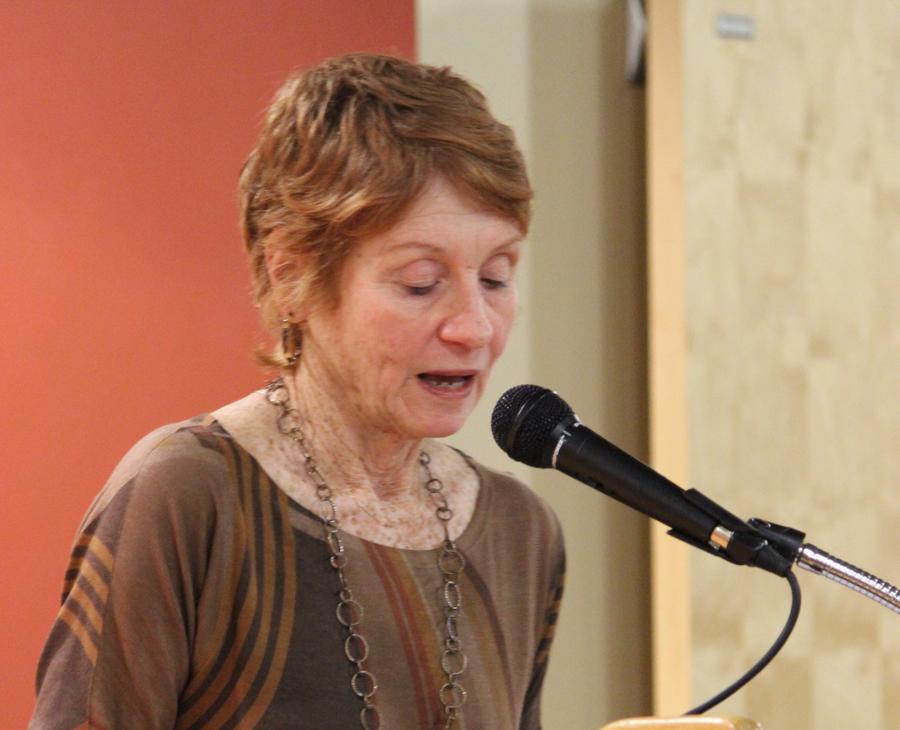Murphy: cuts in staff likely
Barbara Murphy
JSC President Barbra Murphy held a second budget meeting to discuss possible solutions to JSC’s ongoing budgetary problems, including an announcement of likely impending staff cuts.
“We are looking at, with near-certainty, some reductions in staffing,” said Murphy, during the April 5 meeting. “I know how painful this is…It is my hope to make these cuts as fair and equitable as possible across the college. I know it will not feel equitable and fair to everyone, especially someone touched by these reductions.”
The staff reductions will include the elimination of certain as-yet-to-be determined positions. The announcement identifying which specific positions will be cut and who will be affected will be made sometime next week, Murphy said.
According to Murphy, the primary consideration guiding those cuts will be to have as little effect on the students as possible. The cuts will be made as part of the effort to close the $1.5 million gap in the budget for 2015. Murphy attributed the current budget challenges to a variety of factors, including diminished support from the Legislature, the current demographic downturn, a decline in enrollment, some selective blindness by the public about the value of higher education and the obligations to post-retirement costs for JSC employees.
Measures to close the budget gap have been informed by a special budget task force composed of Dean of Student Life and College Relations David Bergh, Business Office Controller Toby Stewart, Dean of Academic Affairs Daniel Regan, Professor of Environmental and Health Sciences Elizabeth Dolci, Dean of Administration Sharron Scott, Professor of Business and Economics Jim Black, Director of Public safety Michael Palagonia, and Director of Athletics and Recreation Jamey Ventura.
This group has been looking at the college’s financial costs and revenue from a small-unit perspective as well from as a large, overall college perspective. They have held a series of meetings to discuss ideas for generating revenue, cutting costs, and saving money. The committee also received hundreds of suggestions from staff, faculty, and students.
All of these suggestions were presented and weighed carefully prior to any cuts.
“I’ve heard two perspectives,” said Murphy. “One is understandable anxiety and confusion, balanced with [the fact that] we have been through this before. This college has had hard financial times and gotten through them.”
Murphy said the 2015 budget is going to be balanced through various savings, revenue from enrollment, and use of one-time reserves. The college is allowed to store up to 5 percent of its budget in these reserves.
Cost-saving measures include a reduction of in-house catering, a reduction of stipends for what Murphy described as “individual pieces of work” and reductions in part-time faculty and overload costs already announced. (See Basement Medicine, Issue 5).
The primary costs driving the 2015 budget are personnel, including retirement benefits, as well as various utilities, such as fuel, and financial aid for students. The largest share of personnel is based in instruction and direct student services.
Sources of potential revenue involve increasing enrollment and retention rates for the college, which Murphy called a multi-year problem. This would mean an increase in both on-campus students and students in the External Degree Program. In an effort to attract more students, several new academic programs will be offered, including sport administration and health sports psychology.
The External Degree Program will also see new courses, such as crisis communications, which will serve as a prototype for a possible master’s program in communications. Another varsity sport for women will be added in hopes of attracting more students.
The college is also planning to promote the new “Finish in 4” initiative.
Murphy took some time to focus on the positive. She noted a significant hiring initiative that may result in eight new full-time faculty members joining the college next fall, the salaries of whom will be largely offset by previous saving measures.
“I believe that the enthusiasm, the preparation, the experience, the versatility and fresh commitment they are going to bring will really be a draw for students and an incentive for students to stay,” said Murphy.
Despite the current budget difficulties, Murphy said the college will prevail. “There are significant challenges ahead, and next year will probably not be the last year for a tight budget,” said Murphy. “I believe in this college’s future. We are almost 200 years old. We’ve got a good mission. We’ve got a strong staff and faculty, highly motivated and dedicated students, and we have strong reasons to be here and thrive.”
Other cost cutting measures under consideration include selling a piece of campus property – either the president’s house or the brown house adjacent to the college apartments – and shutting down the pool in S.H.A.P.E for next year, or at least for part of the year while a number of pool-related issues are studied.
According to JSC Dean of Administration Sharron Scott, the college has fielded hundreds of suggestions regarding ways to close a multi-million dolar budget gap and closing the pool has been one of the items that’s come up multiple times.
Scott said that the overall cost to heat and clean the pool, dehumidify the air, and heat the air is more than $80,000 a year.
Then, with additional cost of life guards and other services, it ends up being more than $100,000 a year, according to Scott.
“The pool is about 25 years old, it was installed in 1989,” Scott said. “The equipment itself is coming to the end of its useful life. In this year alone we’ve had more than $50,000 worth of repairs to it.”
According to Wendy Velander, director of the S.H.A.P.E. Facility and coordinating programer of the pool, most of the paid memberships are from older members of the community, who in fact make up the majority of visitors to the pool.
Revenues from the community offset only a fraction of the pool’s yearly operating costs.
Katie Black, who runs a variety of swim programs at the pool, feels its closing would be a loss for the community.
“The pool is a resource and should be seen as a gem,” she said, citing the community’s use of the facility in a Basement Medicine letter to the editor.
Both Velander and Scott noted the pool is due for some very expensive upgrading due to problems with the Zephyr unit, which heats the pool, and dehumidifies of the air around it.
According to Velander, replacing the aging system could cost up to $500,000.
Closing the pool would also affect work study options at the college. Velander said there are six to eight work study life guards per week.
A decision will be made at the beginning of the summer.
Given serious budget challenges and “near likely” cuts in staff, closing the pool may be yet one of many hard decisions facing the administration in the near future.




